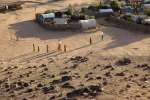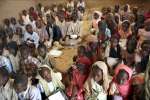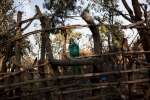Home > About Us > UNHCR Events > World Refugee Day 2009 > World Refugee Day 2009 Photo Galleries
World Refugee Day 2009 Photo Galleries
Afghanistan: An Uncertain Future
For over a quarter of a century, Afghanistan has been devastated by conflict and civil strife, with some 8 million people uprooted internally and in neighbouring countries. The overthrow of the Taliban in 2001 resulted in one of the largest and most successful return operations in history.
Seven years on, more than 5 million Afghan refugees have returned - increasing Afghanistan's population by an estimated 20 percent.The large majority have gone back to their areas of origin. However, some recent returnees are facing more difficulties as the country's absorption capacity reaches its limits in some areas. Last year, some Afghans returned before they were ready or able to successfully reintegrate due to the closure of refugee villages as well as the deteriorating conditions in Pakistan. In consequence, 30,000 Afghan refugees returned to further displacement in their homeland, unable to return to their villages due to conflict, lack of land, shelter materials, basic services and job opportunities. These challenges have been compounded elsewhere across the country by food insecurity and severe drought.
UNHCR and the Afghan Foreign Ministry highlighted the requirements for sustainable refugee return and reintegration at an international conference in Kabul in November 2008. The donor community welcomed the inclusion of refugee reintegration within the government's five-year national development strategy and the emphasis on land, shelter, water, sanitation, education, health care and livelihoods. It is anticipated that repatriation and reintegration will become more challenging in future.
Displaced in North Kivu: A Life on the Run
Fighting rages on in various parts of the eastern Democratic Republic of the Congo (DRC), with seemingly no end in sight for hundreds of thousands of Congolese forced to flee violence and instability over the past two years. The ebb and flow of conflict has left many people constantly on the move, while many families have been separated. At least 1 million people are displaced in North Kivu, the hardest hit province. After years of conflict, more than 1,000 people still die every day - mostly of hunger and treatable diseases. In some areas, two out of three women have been raped. Abductions persist and children are forcefully recruited to fight. Outbreaks of cholera and other diseases have increased as the situation deteriorates and humanitarian agencies struggle to respond to the needs of the displaced.
When the displacement crisis worsened in North Kivu in 2007, the UN refugee agency sent emergency teams to the area and set up operations in several camps for internally displaced people (IDPs). Assistance efforts have also included registering displaced people and distributing non-food aid. UNHCR carries out protection monitoring to identify human rights abuses and other problems faced by IDPs in North and South Kivu.
Darfuri Refugees in Chad: No end in Sight
More than six years after the beginning of the conflict in Sudan's Darfur region, more than a quarter-of-a-million refugees remain displaced in neighbouring Chad. Most of the refugees are women and children and many are still traumatized after fleeing across the border after losing almost everything in land and air raids on their villages.
Families saw their villages being burned, their relatives being killed and their livestock being stolen. Women and girls have been victims of rape, abuse and humiliation, and many have been ostracized by their own communities as a result.
The bulk of the refugees live in 12 camps run by UNHCR in the arid reaches of eastern Chad, where natural resources such as water and firewood are scarce. They have been able to resume their lives in relative peace, but all hope one day to return to Darfur, where hundreds of thousands of their compatriots are internally displaced.
In eastern Chad, UNHCR and other agencies are helping to take care of 180,000 internally displaced Chadians, who fled inter-ethnic clashes in 2006-2007. Some families are starting to return to their villages of origin only now.
Chad's other refugee crisis
While attention focuses on the Darfuris in eastern Chad, another refugee crisis unfolds in southern Chad.
A second refugee crisis has been quietly unfolding in the south of Chad for the past few years, getting little attention from the media and the international community. Some 60,000 refugees from the Central African Republic (CAR) are hosted there in five camps and receive regular assistance from UNHCR. But funding for aid and reintegration projects remains low. Refugees have been fleeing fighting between rebel groups and governmental forces in northern CAR. 17,000 new refugees have arrived from northern CAR to south-eastern Chad since the beginning of 2009.





























































